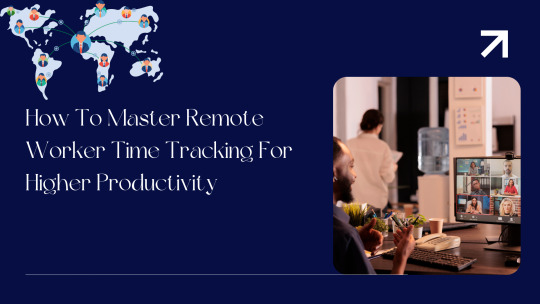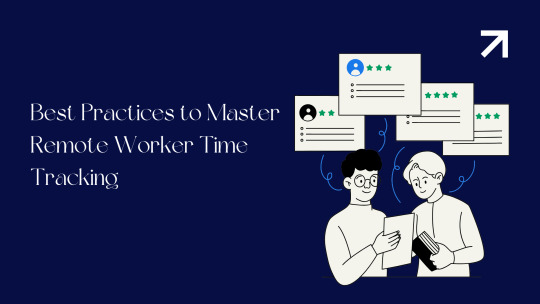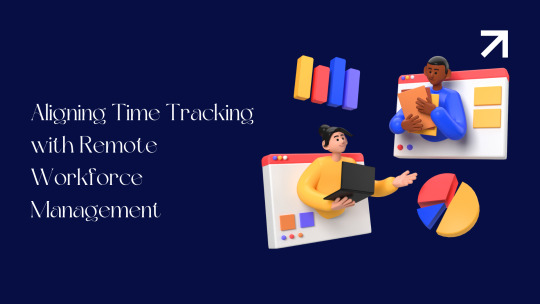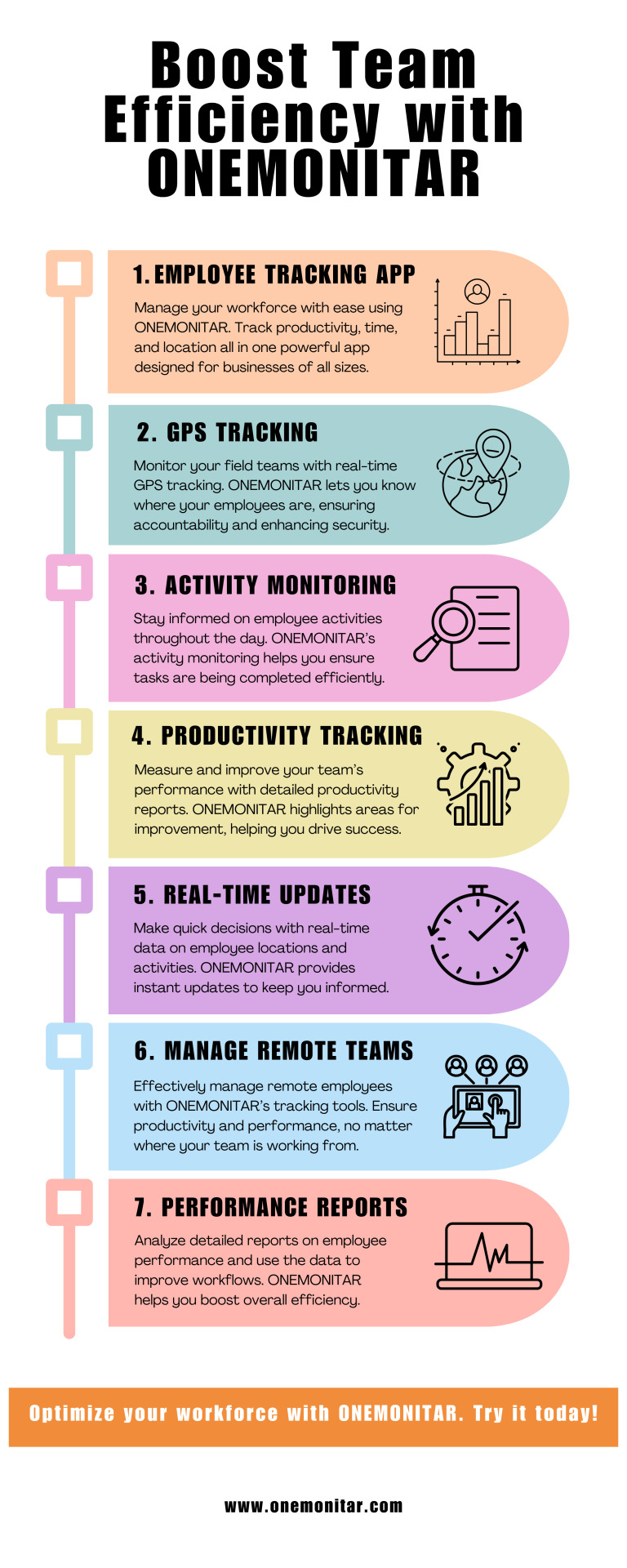#remote employee monitoring software
Explore tagged Tumblr posts
Text
The Future of Workplace Efficiency: Employee Monitoring Software
As businesses strive to optimize productivity and maintain efficiency, employee monitoring software has become a crucial tool for organizations worldwide. Whether managing remote teams or tracking in-office employees, productivity monitoring software enables businesses to monitor work patterns, ensure accountability, and improve overall efficiency.

What is Employee Monitoring Software?
Employee productivity monitoring software is a technology that helps employers track work activities, monitor attendance, and analyze performance trends. By leveraging features such as time tracking with screenshots, AI-powered insights, and real-time analytics, businesses can enhance workflow and ensure employees remain engaged during work hours.
Essential Features of Productivity Monitoring Software
1. Time Tracking with Screenshots
One of the most effective ways to ensure productivity is time tracking with screenshots. This feature captures real-time snapshots of employees’ screens at regular intervals, helping employers verify progress, detect inefficiencies, and ensure accountability.
2. Remote Employee Monitoring
With the rise of remote work, companies need reliable remote monitoring software for employees. Software to monitor remote workers enables businesses to track login times, work hours, and overall activity, ensuring remote employees stay focused and productive.
3. AI-Driven Analytics
AI-powered employee monitoring software takes workforce optimization to the next level. AI employee monitoring software analyzes behavior patterns, identifies trends, and provides data-driven recommendations for improving productivity.
4. Website & Application Tracking
Employee productivity monitoring software allows businesses to track which websites and applications employees use during work hours. This feature helps identify distractions and enables managers to take proactive steps in ensuring efficient work habits.
5. Real-Time Alerts and Reports
Advanced productivity monitoring software generates real-time alerts and reports to highlight inefficiencies, detect policy violations, and provide insights into employee performance. These automated reports help managers make informed decisions and optimize workflows.
Benefits of Using Employee Monitoring Software
1. Increased Productivity
By tracking work activities, companies can ensure employees stay focused on their tasks, reducing time wasted on non-work-related activities.
2. Better Accountability and Transparency
Remote employee monitoring software ensures that employees remain accountable for their performance and attendance, fostering a transparent work environment.
3. Enhanced Data Security
By monitoring employee activity, businesses can prevent unauthorized data access, ensuring compliance with security regulations and reducing cybersecurity risks.
4. Optimized Workload Distribution
AI-driven employee productivity monitoring software provides insights into workload distribution, helping managers allocate resources efficiently and prevent employee burnout.
5. Improved Employee Engagement
Contrary to concerns about surveillance, monitoring software can enhance engagement by helping employees manage their time effectively and stay focused on essential tasks.
Choosing the Right Employee Monitoring Software
When selecting employee productivity monitoring software, businesses should consider:
Scalability: Ensure the software grows with your business.
Ease of Use: A user-friendly interface ensures seamless adoption.
Customization: Look for software with flexible tracking settings.
Compliance & Privacy: Ensure adherence to data protection regulations.
Integration: The software should work with existing business tools for seamless operations.
Ethical Considerations and Best Practices
While employee monitoring software is a powerful tool for productivity enhancement, it is essential to implement it ethically. Businesses should:
Maintain Transparency: Inform employees about monitoring policies and obtain their consent.
Set Clear Guidelines: Define what is being monitored and ensure employees understand the purpose.
Respect Privacy: Avoid excessive surveillance that may lead to distrust or discomfort among employees.
Use Data Responsibly: Monitoring data should only be used for improving productivity and ensuring compliance, not for micromanagement.
Conclusion
As remote work and digital workplaces continue to grow, remote employee monitoring software is becoming essential for maintaining productivity, accountability, and security. Whether utilizing time tracking with screenshots, AI-driven analytics, or software to monitor remote workers, businesses that implement employee productivity monitoring software can expect improved efficiency, optimized workflows, and long-term success. Selecting the right software and using it ethically will help businesses unlock their full potential while maintaining a positive and transparent work culture.
0 notes
Text
Application for attendance
Holiday management software can make requests for time off from employees and their schedules easily managed. Nobody can think of a time when managing vacation requests and attendance was simpler. With the help of Reptile Tracko, you can simplify the process of managing all of this and enhance the scheduling of your staff, by keeping accurate records helped by holiday tracking software—all inside a single, user-friendly online platform. Our employee holiday management software is designed to be flexible enough to accommodate the specific requirements of your business, which will result in smoother operations and happier staff.
1 note
·
View note
Text
Boost productivity, enhance accuracy, and streamline workforce management to focus on what truly matters—your team’s success. Effortlessly manage employee attendance with real-time tracking, automated reports, and seamless integration. Simplify scheduling, monitor time-offs, and ensure compliance with ease

#remote employee monitoring software#desktop monitoring software#employee monitoring software#work from home tracking software#remote work tracking software
0 notes
Text
How To Master Remote Worker Time Tracking For Higher Productivity

In today’s flexible work environment, where remote and hybrid work models are becoming standard, effective time tracking is the backbone of productivity. With teams scattered across different locations, leaders are actively seeking solutions to ensure performance doesn’t decline outside the office. Mastering remote worker time tracking can not only improve output but also strengthen team accountability and trust.
Let’s explore how to manage time efficiently for distributed teams, especially within the context of hybrid models and strategic remote workforce management.
Why Time Tracking Matters in Remote Work
Remote work offers freedom, but it also demands discipline. Time tracking ensures:
Transparency: Teams know where their hours go.
Accountability: Employees stay responsible for their schedules.
Productivity insights: Managers can identify bottlenecks or overwork.
Better project planning: Time data improves forecasting and budgeting.
Using a reliable system for remote worker time tracking ensures tasks are completed on time and aligned with business goals, even when the team is scattered.
Understanding the Hybrid Remote Meaning
Before diving into time tracking tools and techniques, it’s important to understand the hybrid remote meaning. Hybrid remote refers to a working model where employees split their time between remote locations and the physical office. This flexible setup allows for autonomy and better work-life balance but can introduce challenges related to supervision, communication, and time management.
In such environments, it's essential for businesses to adopt clear workflows, define expectations, and use smart tools to keep productivity high without micromanaging.
Best Practices to Master Remote Worker Time Tracking

Here are some proven strategies to help teams track time efficiently:
1. Set Clear Working Hours and Guidelines
Employees should know when they are expected to work and how they should log their time. Define:
Standard start and end times
Break durations
Availability hours for meetings
2. Use the Right Tools
Choose software that suits your company’s needs. Features to consider:
Automatic time tracking
App and URL usage monitoring
Project-based logging
Real-time reporting dashboards
These tools make tracking seamless without disrupting workflows.
3. Encourage Daily Time Logs
Ask team members to log their time daily. This reduces errors and builds the habit of self-assessment.
4. Review and Discuss Reports
Managers should review weekly time reports and offer feedback. This fosters:
Recognition for high performers
Support for those struggling
Identification of process inefficiencies
5. Respect Employee Privacy
Tracking should not feel invasive. Avoid excessive surveillance. Instead, build trust by being transparent about:
What data is collected
How it will be used
How it benefits both parties
Aligning Time Tracking with Remote Workforce Management

Time tracking should be a part of broader remote workforce management efforts. It’s not just about logging hours—it’s about understanding how employees spend their time and supporting them in improving their output.
Here's how to integrate it:
Performance reviews: Use tracked time data to evaluate results, not just hours.
Team scheduling: Coordinate work hours based on real-time availability.
Goal setting: Set achievable goals using past time tracking insights.
Skill development: Identify where training may be needed based on how time is spent.
A data-driven approach fosters stronger collaboration and employee satisfaction, two essentials in any modern remote setup.
You can also watch: Workforce Management Made Easy With EmpMonitor!
youtube
Final Thoughts
As work models evolve, so must our methods of team supervision and performance evaluation. Mastering the art of remote worker time tracking goes beyond installing software—it's about creating a culture of trust, efficiency, and continuous improvement.
When properly implemented within the hybrid model and broader remote workforce management strategies, time tracking can transform how teams operate—leading to higher productivity, happier employees, and better business outcomes.
#Remote Worker Time Tracking#remote work monitoring software#time tracking for remote employees#remote worker tracking software#time tracker#time tracking software#employee time tracker#Youtube
0 notes
Text
Seamless Remote Employee Monitoring Software
Use cutting-edge remote employee monitoring software to stay updated on how your workforce performs across different time zones. Capture data on attendance, screen time, and productivity trends. Easily generate reports and spot performance gaps with real-time insights. It’s the simplest way to manage and improve remote work environments, especially when transparency and accountability matter most.
0 notes
Text
Top Productivity Tools for HR Leaders
Looking to supercharge your HR game? Check out the ultimate productivity tools that can help HR leaders elevate employee engagement and keep retention rates high. This guide dives into the must-have tools that simplify HR tasks, boost communication, and foster a thriving workplace culture. It's an essential read for HR pros who are ready to make a real impact in 2025.
#employee productivity software#software to track employee productivity#Productivity tracking tools#employee productivity app#employee productivity tracker#employee monitoring tool#employee productivity tools#monitor remote employee productivity
0 notes
Text
Explore our list of top employee monitoring software options in the UK. From tracking work hours to monitoring productivity, these tools can support your team management needs.
#employee monitoring software#UK Software#productivity software#workforce management software#Employee trackinhg#remote team management#best monitoring software#best software#top software
0 notes
Text
Boost Team Efficiency with ONEMONITAR

Looking for an efficient way to manage your team and boost productivity? Check out ONEMONITAR's employee tracking app infographic! Discover how you can easily track employee activities, monitor GPS locations, and get real-time updates—all from one app. Whether you're managing a remote team or need detailed performance reports, ONEMONITAR helps you stay on top of your workforce and improve results.
Boost your business performance today with ONEMONITAR!
#Best employee tracking app#Employee monitoring software#GPS employee tracking app#Employee activity monitoring app#Employee productivity tracking app#Employee tracking app for Android#Remote employee tracking app#Real-time employee tracking app#Employee location tracking app#Employee tracking software for small business#Employee performance tracking app#Mobile employee tracking app
0 notes
Text

Top 5 Benefits of Employee Monitoring Software for Remote Teams Discover the top 5 benefits of using employee monitoring software for your remote teams. This powerful tool enhances productivity, accountability, and collaboration in the digital workplace. Key advantages include real-time productivity tracking, improved employee accountability, better communication among remote workers, valuable data-driven insights for managers, and reduced distractions for focused work. Implement employee monitoring software to optimize your remote team's performance and achieve your business goals efficiently. Unlock the full potential of your distributed workforce with this essential tool.
#employee monitoring software in india#employee monitoring software#employee monitoring#remote teams#real time employee monitoring software#remote employee monitoring
1 note
·
View note
Text
How AI-Powered Employee Monitoring Software Enhances Remote Team Management
The rise of remote work has transformed the traditional office environment, offering businesses and employees greater flexibility and freedom. However, managing a distributed workforce presents unique challenges, including maintaining productivity, ensuring accountability, and managing performance effectively. AI employee monitoring software has emerged as a powerful solution, helping organizations overcome these challenges and optimize remote team management.
This article explores how AI-driven monitoring tools can enhance productivity, streamline workflows, and support remote workforce management while promoting a healthy work culture.

The Need for Employee Monitoring Software in Remote Work
The shift to remote work has created a need for tools that offer visibility into employee activities and performance. Unlike traditional office settings where managers can observe work habits directly, remote work requires digital solutions to bridge the gap.
Employee monitoring software provides managers with insights into work patterns, tracks productivity, and helps maintain accountability. When combined with artificial intelligence, these tools offer advanced features like productivity analytics, real-time activity tracking, and anomaly detection, enabling data-driven management strategies.
Key Features of AI-Powered Employee Monitoring Software
AI-driven employee monitoring tools come equipped with advanced features tailored to support remote work environments:
1. Real-Time Activity Tracking
AI-powered software offers real-time insights into employee activities, allowing managers to monitor application usage, web browsing, and task progress. This feature helps identify productivity patterns and detect potential issues early.
2. Productivity Analytics
AI algorithms analyze data to provide detailed productivity reports. These insights help managers understand how employees spend their work hours, identify bottlenecks, and optimize workflows for maximum efficiency.
3. Automated Time Tracking
Automatic time tracking features record the duration employees spend on tasks and applications. This helps maintain accurate records of work hours, ensuring fair assessments of productivity and workload management.
4. Screen Monitoring and Recording
Screen capture features allow managers to view snapshots of employee screens at regular intervals. This feature enhances transparency and is particularly useful for industries requiring compliance with strict regulations.
5. Behavior Analysis and Anomaly Detection
AI-driven software can detect unusual behavior patterns, such as sudden drops in productivity or extended periods of inactivity. This helps managers address potential issues before they affect team performance.
Benefits of Employee Monitoring Software for Remote Teams
Implementing AI-powered employee monitoring software offers several advantages for managing remote teams effectively:
1. Enhancing Productivity
Monitoring software helps managers identify how employees utilize their work hours. By analyzing productivity trends, organizations can implement strategies to reduce distractions and improve focus.
2. Supporting Accountability and Transparency
When working remotely, maintaining accountability can be challenging. Monitoring software provides objective data on employee performance, promoting transparency and accountability across teams.
3. Improving Time Management
Time tracking features enable employees to manage their schedules more efficiently. By understanding how time is allocated to different tasks, both managers and employees can optimize work routines.
4. Streamlining Performance Management
AI-driven analytics provide insights into employee performance over time. Managers can use this data to set realistic performance goals, identify top performers, and support employees who may need additional guidance.
5. Facilitating Data-Driven Decisions
The analytics provided by AI-powered software allow managers to make informed decisions regarding resource allocation, project management, and team development.
6. Supporting Compliance and Security
Monitoring tools help businesses maintain compliance with data protection regulations by tracking data access and usage. Additionally, they can enhance security by detecting suspicious activities and preventing data breaches.
Best Practices for Implementing Employee Monitoring Software
While employee monitoring software offers significant benefits, it is important to implement it thoughtfully to maintain trust and a positive work culture:
1. Maintain Transparency with Employees
Communicate openly with employees about the implementation of monitoring software. Explain the purpose, benefits, and how the collected data will be used. Transparency helps build trust and reduces concerns about privacy.
2. Establish Clear Policies
Develop clear guidelines on what will be monitored, how data will be used, and how the software aligns with company objectives. These policies should emphasize productivity improvement and support rather than surveillance.
3. Focus on Performance, Not Surveillance
Monitoring should be used as a tool to support productivity and enhance performance, not as a means to micromanage or invade privacy. Emphasize that the goal is to create a more efficient and supportive work environment.
4. Respect Employee Privacy
Set boundaries to ensure that monitoring only occurs during work hours and in professional contexts. Avoid tracking personal activities or off-hours behavior.
5. Provide Constructive Feedback
Use insights from the software to offer constructive feedback to employees. Highlight positive performance and provide guidance on areas that need improvement.
Real-World Examples of Successful Remote Team Management
Many businesses have successfully used AI-powered employee monitoring software to manage remote teams:
1. TechNova Solutions
TechNova implemented employee monitoring software to manage its remote development team. The software helped identify workflow inefficiencies, enabling the company to streamline processes and improve productivity by 30%.
2. CreativeHub Agency
As a digital marketing agency with a global workforce, CreativeHub used monitoring tools to enhance collaboration and transparency. The software’s analytics helped managers allocate resources effectively, resulting in a 25% increase in project completion rates.
3. FinSecure Financial Services
Operating in a highly regulated industry, FinSecure utilized monitoring software to maintain compliance and security while managing remote employees. The software provided detailed reports on data access and helped prevent potential security breaches.
Challenges of Employee Monitoring and How to Overcome Them
While monitoring software offers numerous benefits, organizations may face challenges related to privacy and employee morale:
1. Balancing Monitoring and Trust
Over-monitoring can lead to a loss of trust among employees. To prevent this, companies should adopt a balanced approach that emphasizes productivity support rather than surveillance.
2. Ensuring Ethical Use of Data
Employee data should be handled ethically and in compliance with data protection laws. Businesses should avoid collecting unnecessary personal information and ensure data security.
3. Avoiding Micromanagement
Monitoring software should not replace healthy management practices. Instead, it should complement traditional management techniques by providing additional insights and supporting informed decision-making.
Conclusion
AI-powered employee monitoring software is a valuable tool for managing remote teams effectively. By providing real-time insights, enhancing productivity, and promoting accountability, these tools empower managers to maintain high performance standards in remote work environments.
However, to achieve the best results, businesses must implement monitoring software with transparency, respect for privacy, and a focus on productivity enhancement rather than strict surveillance. By maintaining a balanced approach, organizations can foster a positive work culture that supports remote employees and drives business success.
As remote work continues to evolve, leveraging advanced technologies like AI-driven monitoring tools will become increasingly important for businesses aiming to stay competitive, productive, and agile in the modern workplace.
#employee monitoring software#remote employee monitoring software#AI employee monitoring software#AI employee monitoring system
0 notes
Text
How Can Employee Productivity Tracker Streamline Project Management?
In today's dynamic work environment, where deadlines loom and resources are often stretched thin, managing diverse projects with remote employees is one of the biggest challenges for managers. However, a centralized employee productivity tracker can be your trusted ally to monitor how your employees utilize their time and resources. Since this tool provides insightful data in real-time, organizations can seamlessly navigate through the complexities with greater clarity regarding project progress.
Imagine a situation wherein every activity of your employee is visible remotely and a dashboard that paints a clear picture of the team’s performance, hidden insights into workflow, and overall business strategies. Sounds too good to be true, right? An employee tracking solution frees managers from guesswork as it offers accurate insights into the productivity levels of every team member, time taken to complete tasks, and employee performance. Also, it aids in identifying bottlenecks in the workflows.
In this blog, we will highlight practical ways to manage diverse projects with remote employees by utilizing robust features of employee time-tracking apps for your better understanding.
What is Employee Tracking Software?
Monitoring the productivity of your remote employees can be difficult when done manually through calls or emails. With the rising shift towards remote work environments, managers are finding it difficult to enhance work efficiency, drive scalability, and achieve overall business success. Hence, it is imperative for businesses to adapt innovative tools to manage remote teams and enhance productivity.
In addition, TrackOlap employee monitoring software provides insightful data on several parameters in real-time, supporting businesses in making informed decisions and continuously enhancing workflows and other improvements. As a manager, you can observe employees' behavior during working hours, identify areas for improvement in team performance, and ensure the overall business operation thrives.
Lastly, by tracking employees' activities and work efficiency through a central dashboard, managers can save time from constantly following up with employees and maximize ROI.
What Metrics Does Employee Productivity Tracker Record?
As mentioned above, an employee productivity tracker enables businesses to track team activities, productivity levels, and more. This enables managers to consistently track progress over varied projects, identify inaccuracies in real-time, and make adjustments promptly to avoid delayed submissions or interrupted workflows. Let us explore a range of metrics that this software offers to multiple businesses.
Time Utilized: Average time spent on per task or project. Remote work management software offers a seamless data breakdown of where your resources spend time.
Employee’s Idle Time: An employee time tracking app captures the total number of breaks or duration of time off amid working hours to help managers identify unproductive team members
Computer Activity: Tracks website, documents, and applications visited by employees during working hours to determine their active time
Completed Tasks: Based on the overall output delivery, employee tracking solution keeps a record on overall completed tasks to optimize resource allocation strategy for the team
Moreover, employee time-tracking app tends to answer a range of questions with added clarity:
At what time does the team log-in and log-out?
Who are the underperformers and top performers in the team?
What sites is the team viewing, and for how much time?
What resources do we need to acquire project objectives?
Where do we need to focus on to drive better revenue?
You May Also Like: How can Remote Work Management Software Enhance Business Operations?
Why is there a sudden drop in the remote team’s performance?
The metrics of remote work management software collectively offer visibility to the managers for time management and overall productivity of the team to consistently improve business operations, workflows and other aspects hassle-free.
Top Reason Why You Need Employee Productivity Tracker
Maintaining productivity is important for every business irrespective of what you do, and what you offer. It can become a complex process if you work with a remote team. Hence, implementing a robust employee productivity tracker is extremely important in today’s fast-paced world. Let us explore a few benefits of this software.
1. Effective Project Management
Managers can effortlessly manage project schedules and essential assignments through a centralized employee time-tracking app. By accessing historical data on parameters like employee performance, caliber, productivity levels, and more - as a manager, you can schedule tasks or allocate assignments based on the timeframe.
By constantly tracking their activities, you can immediately capture inaccuracies and find alternative solutions without interrupting the project's scheduled workflow.
2. Strategic Resource Allocation
Consistently monitoring employees’ productivity levels through remote work management software aids in identifying areas of h igh and low efficiency in the team. This data will support you with planning strategic resource allocation and ensure equal workload distribution.
In addition, centralized dashboards are an additional benefit for managers to access an overview of the entire team’s activities. Whether it is project deadlines, allocating assignments according to employees' expertise, staffing level, or overall team workload capability, an employee productivity tracker can come to your rescue.
3. Thorough Performance Analysis
Are you looking to re-align your allocation process? Access productivity levels and overall output delivered by your team members in previous weeks or months to determine their performance. Additionally, through graphically-rich reports, you will have a better picture of the overall team’s progress and encourage them to perform better from these analytics to drive better outcomes.
4. Assess Return on Investment (ROI)
By tracking your team’s productivity levels through employee tracking solutions, you can also analyze the effectiveness of the investment you made in varied tools, resources, and more. Yes, you heard it right! You can evaluate the overall output delivered by your team, their efforts, or work efficiency to understand the profitability of your projects and make better decisions for future endeavors.
5. Evaluate Workload Balance & Employee Burnouts
If your resource allocation strategy isn't optimized, or if you fail to manage equal workload within your team, your employees may feel burnout very frequently, which can ultimately affect their well-being.
However, many factors can lead to employee burnout, such as an imbalance in workload for a longer period of time. When you track productivity levels, if you observe uneven results, such as high-performers being unproductive or a sudden drop in overall output delivery, then it is an indication that they are on the edge of experiencing burnout.
Hence, it is important to set a realistic timeline for every delegated task, track achievable targets promptly, and ensure every employee has a suitable workload that is important for achieving project success.
6. Track Goals and Achievements
Tackling your employees' efficiency levels aids in setting realistic goals. Regularly measuring progress for these objectives will keep you aligned with minute progress. Additionally, evaluating reports like productivity vs. targets acquired assists in motivating employees to work closely to achieve specific goals and encourages teams to be accountable for certain aspects.
How to Manage Projects with Employee Tracking Solutions?
TrackOlap provides comprehensive software to manage projects, remote teams, and upscale business profitability with robust features. However, this software goes beyond productivity or time tracking as it offers valuable insights on many parameters that might otherwise go untapped.
1. Tracks Time Autonomously
It is important to understand your objectives before you implement varied strategies. Based on your objectives, consider integrating a time tracker like TrackOlap to foster accountability and transparency into the workflow and avoid interrupting your employees' privacy.
Since this software seamlessly tracks computer usage by activities, visited sites, documents, or apps, it helps managers access the active time of every employee. This can be helpful for organizations that have team members from different time zones. Moreover, these features remove the process of back-and-forth follow-ups, manual log-ins, and updating progress on every task.
2. Setting Productivity Benchmarks
Employee tracking solutions simplify the process of identifying when employees are productive and when they trick the team with time theft. This can help managers address such concerns in real-time and collaborate with employees in 1:1 sessions to boost business growth.
By encouraging employees to perform better and focusing on activities for employee development, you are likely to set high benchmarks for employee productivity. This approach will encourage team members to perform better and be focused, especially when their efforts are acknowledged and appreciated with a certain level of recognition. Ultimately, all these aspects will lead to better revenue, satisfied clients, and retained employees.
3. Effective Project Budgeting
Managers can conduct a thorough project cost analysis through data-driven reports based on the employee's performance, productivity levels, and amount of output delivered in previous months. Based on this analysis, businesses can estimate an average feasible timeline to complete a project without causing burnout among team members and an overall budget to ensure you achieve significant profitability with your existing team.
4. Customized Reporting and Analysis
Whether you want to determine the effectiveness of your resource allocation strategy, workflow efficiency, productivity levels, employee accountability, or team performance - TrackOlap simplifies the evaluation process by offering a robust feature for creating customizable reports based on specific parameters.
Moreover, a centralized dashboard offers an overview and statistics that give the organizations a clear picture of varied aspects and departments, supporting consistently making informed decisions hassle-free.
Final Thoughts
In today’s dynamic environment, an employee productivity tracker is valuable for businesses. It not only enhances productivity levels but also offers accurate data on work output and the effectiveness of varied strategies with clear visibility. Moreover, managers can easily manage teams and projects without micromanaging daily, thanks to features like idle time tracking, customized reports, and more metrics.
Transform your business profitability and change how you manage projects by adopting a time-tracking tool into your system. Contact us to get a quick demo of these features today!
#employee time tracking software#Lead automation app#Employee Productivity Tracker#employee time tracking app#system idle time tracking software#employee monitoring software#employee time tracker#remote work management software#remote team management software
0 notes
Text

Productivity Tips for Hybrid Teams
Hybrid teams can boost productivity by fostering productivity tools for hybrid teams and clear communication, setting shared goals, and maintaining flexibility. Encourage structured workflows with regular check-ins while allowing autonomy to accommodate remote and in-office dynamics.
#work from home tracking software#remote employee monitoring software#time tracking software#desktop monitoring software#employee monitoring software
0 notes
Text
Remote Collaboration: Tools & Strategies For Virtual Teams

It has become increasingly prevalent, driven by the rise of global teams and the need for flexibility in work arrangements. Effective remote-collaboration bridges the gap between team members who may be scattered across different time zones, cultures, and work environments.
Central to remote collaboration are digital tools that facilitate communication, project management, and document sharing. Platforms like Slack, Microsoft Teams, and Zoom have revolutionized how teams interact, enabling real-time messaging, video conferencing, and collaborative document editing. These tools not only enhance communication but also ensure that team members can work together seamlessly, regardless of their physical location.
Key to successful remote-collaboration is the establishment of clear communication protocols and expectations. This includes defining which tools to use for different types of communication—instant messaging for quick questions, email for formal communications, and video calls for meetings. Additionally, fostering a culture of transparency and inclusivity is crucial, ensuring that all team members feel connected and engaged, despite the physical distance.
Remote Team Collaboration
Remote team collaboration involves using digital tools and strategies to facilitate effective teamwork among members who are geographically dispersed. It has become a crucial aspect of modern work environments, driven by the increase in remote work arrangements and global teams. Here’s an overview of key components and best practices for successful remote-collaboration:
Communication Tools: Platforms like Slack, Microsoft Teams, and Zoom enable real-time communication through instant messaging, video conferencing, and calls. These tools are essential for maintaining regular contact, hosting virtual meetings, and ensuring that team members can quickly address issues and share updates.
Project Management Software: Tools such as Trello, Asana, and ClickUp help teams organize tasks, set deadlines, and track progress. These platforms often include features for assigning tasks, setting priorities, and visualizing workflows, which help keep everyone on the same page.
Collaborative Document Editing: Google Workspace and Microsoft 365 provide cloud-based solutions that allow multiple users to work on the same documents simultaneously. This is crucial for creating and editing shared files, ensuring that all team members have access to the latest versions.
Collaboration Tools For Remote Teams
Collaboration tools have become indispensable for remote teams. These tools foster communication, enhance productivity, and ensure seamless project management, despite the physical distances separating team members.
Among the most popular are communication platforms like Slack and Microsoft Teams, which offer instant messaging, video conferencing, and integration with other software, allowing for real-time discussions and quick decision-making for work from home people. Video conferencing tools such as Zoom and Google Meet have revolutionized virtual meetings, making face-to-face interaction possible, which is crucial for maintaining team morale and clarity.
Project management tools like Trello, Asana, and Monday.com help teams organize tasks, set deadlines, and track progress through visual boards and timelines, ensuring everyone is on the same page. For document collaboration, Google Workspace and Microsoft Office 365 provide cloud-based solutions where multiple users can work on documents simultaneously, leaving comments and edits in real-time.
Is Employee Monitoring Software Worth It?

The worth of employee monitoring software largely depends on the specific needs and goals of a business. Here are some key considerations:
Pros
Productivity Tracking: Employee monitoring software can help track productivity by providing data on how employees spend their time. This can identify inefficiencies and help optimize workflows. Tracking employees can also be considered a Productivity Hack.
Accountability: It ensures employees are accountable for their work, which can be particularly important in remote work settings where direct supervision is challenging.
Security: Monitoring software can protect sensitive information by detecting unauthorized access and preventing data breaches.
Time Management: It can track time spent on various tasks, helping managers allocate resources more effectively and employees manage their own time better.
Cons
Privacy Concerns: Monitoring can lead to privacy issues and create a sense of distrust among employees. It's crucial to implement it transparently and ethically.
Morale And Trust: Over-monitoring can negatively impact employee morale and trust. Employees may feel micromanaged and stressed, which can reduce overall job satisfaction and productivity.
Cost: Implementing and maintaining monitoring software can be costly, and businesses need to weigh this against the potential benefits.
Legal Implications: There are legal considerations and regulations regarding employee monitoring that vary by region. Companies must ensure compliance to avoid legal issues. Also Watch: Leading Employee Engagement and Workforce Productivity Tool
youtube
Conclusion
In conclusion, remote collaboration are essential in today's increasingly digital and globalized work environment. They bridge the gap created by physical distances, enabling seamless communication, efficient project management, and collaborative work on documents and code.
Tools like Slack, Zoom, Trello, and Google Workspace ensure that remote teams can stay connected, organized, and productive. By fostering a culture of transparency, accountability, and continuous communication, these tools not only enhance productivity but also support team morale and cohesion. As remote work continues to grow, the importance and utility of these collaboration tools will only increase, making them indispensable for the future of work.
#Remote Collaboration#remote team collaboration#remote teamwork#collaboration tools#employee monitoring software#Youtube
0 notes
Text
How Businesses Can Improve Productivity with time tracking with screenshots
Managing a remote workforce comes with challenges, but using time tracking with screenshots and remote monitoring software for employees helps businesses ensure efficiency, accountability, and structured workflows. These tools provide real-time insights into employee performance, helping organizations maintain productivity while working remotely.

Enhancing Productivity with Accurate Tracking
One of the most effective ways to measure employee efficiency is through time tracking with screenshots. This feature allows businesses to monitor work activity in real time, capturing visual proof of tasks being performed. By analyzing these screenshots, managers can gain insights into employee engagement, ensuring that tasks are completed efficiently.
Encouraging Accountability and Transparency
Using remote monitoring software for employees promotes a transparent work environment by providing clear records of employee activities. Screenshots taken at random intervals prevent manual time entries from being misrepresented and ensure that logged work hours accurately reflect actual contributions. Employees can review their own tracked time, making it easier for them to manage workloads and stay on schedule.

Effective Task Management and Workflow Optimization
Businesses that rely on time tracking with screenshots can streamline task management by identifying workflow bottlenecks. If employees are spending too much time on specific tasks, managers can allocate resources more effectively. Remote monitoring software for employees provides real-time analytics, helping businesses make informed decisions about task assignments and deadlines.
Strengthening Security and Compliance
Data security is a major concern for businesses operating remotely. Remote monitoring software for employees ensures that confidential information remains protected by tracking unauthorized access and recording system activity. Features like time tracking with screenshots can also help in compliance audits, providing verifiable proof of employee work history and project completion.
Improving Team Collaboration
When employees work remotely, maintaining seamless communication is crucial. Many remote monitoring software for employees solutions integrate with collaboration tools, enabling teams to stay connected and aligned on project goals. Time tracking with screenshots also helps managers provide constructive feedback based on recorded activities, ensuring employees remain on the right track.
Scalability for Business Growth
Companies of all sizes can benefit from remote monitoring software for employees. Whether managing a small team or a large workforce, these tools can scale to meet business needs. Time tracking with screenshots ensures that as companies grow, they maintain a high level of productivity and accountability across all departments.
Conclusion
To maintain productivity and accountability in a remote work environment, businesses need time tracking with screenshots and remote monitoring software for employees. These tools provide transparency, improve workflow efficiency, and enhance security while ensuring seamless task management. Investing in these solutions allows companies to monitor performance effectively while fostering a culture of trust and accountability. To find a reliable solution that meets your business needs, visit telemore.ai.
0 notes
Text
Best Remote Employee Monitoring Software for Managing Distributed Teams

In the modern workplace, the shift towards remote work has become a defining characteristic of many organizations. As teams become increasingly distributed, the need for effective employee monitoring software has never been more critical. This article aims to provide a comprehensive guide to the best remote employee monitoring software available, focusing on their features, benefits, and how they can enhance productivity and accountability within your team.
Understanding Remote Employee Monitoring Software
Remote employee monitoring software is designed to help organizations track and manage their employees' activities while they work from various locations. These tools can provide insights into productivity levels, time management, and overall performance. By understanding the capabilities of these software solutions, businesses can make informed decisions about which tools best meet their needs.

Key Features to Look For
When evaluating remote employee monitoring software, it is essential to consider several key features that can significantly impact its effectiveness:
Time Tracking: The ability to monitor how much time employees spend on tasks is crucial for assessing productivity.
Activity Monitoring: This feature allows managers to see what applications and websites employees are using during work hours.
Screen Capture: Some software includes the option to take screenshots at intervals, providing a visual record of employee activity.
Reporting and Analytics: Comprehensive reporting tools can help managers analyze productivity trends and identify areas for improvement.
Integration Capabilities: The ability to integrate with other tools and platforms can enhance the software's functionality.
Benefits of Using Employee Monitoring Software
Implementing remote employee monitoring software can yield numerous benefits for organizations, including:
Increased Accountability: Employees are more likely to stay focused and productive when they know their activities are being monitored.
Enhanced Productivity: By identifying time-wasting activities, managers can help employees optimize their work habits.
Improved Communication: Many monitoring tools include features that facilitate communication between team members and managers.
Data-Driven Decisions: Access to detailed reports allows managers to make informed decisions regarding team performance and resource allocation.
Top Remote Employee Monitoring Software Solutions
With a plethora of options available, selecting the right remote employee monitoring software can be daunting. Below, we highlight some of the top solutions based on user reviews, functionality, and overall effectiveness.

1. MaxelTracker
MaxelTracker is an advanced AI-powered employee monitoring tool that maximizes productivity while maintaining employee privacy. It leverages AI-based analysis and real-time monitoring to provide actionable insights into work patterns and allow firms to maximize efficiency without compromising autonomy.
Key Features
Live Activity Monitoring – Track work in real-time with smart screenshot capture.
AI-Driven Productivity Insights – Monitor departmental performance and streamline workflows.
GPS Tracking & Role-Based Access – Secure and effective monitoring, especially in the case of remote teams.
Privacy-Focused Features – Includes screenshot blurring to conceal personal information.
MaxelTracker is the ideal solution for organizations looking to improve efficiency and ensure an open and productive work culture.
1. Time Doctor
Time Doctor is a robust time-tracking and employee-monitoring tool that offers a range of features designed to enhance productivity. Its user-friendly interface makes it easy for employees to log their hours and track their tasks.
Key Features: Time tracking, screenshot capture, web and app usage monitoring, and detailed reporting.
Pros: Intuitive design, excellent customer support, and integration with various project management tools.
Cons: Some users report that the screenshot feature can feel intrusive.
2. Hubstaff
Hubstaff is another popular choice for remote employee monitoring, offering time tracking, GPS tracking, and productivity monitoring features. It is particularly beneficial for teams that require location tracking for fieldwork.
Key Features: Time tracking, GPS tracking, project management tools, and invoicing capabilities.
Pros: Versatile features, easy to use, and strong reporting capabilities.
Cons: The mobile app can be less reliable than the desktop version.
3. ActivTrak
ActivTrak focuses on employee productivity and behavior analytics, providing insights into how employees spend their time. This software is ideal for organizations looking to foster a culture of productivity.
Key Features: Activity monitoring, productivity analytics, and customizable reporting.
Pros: Comprehensive analytics, user-friendly interface, and strong privacy controls.
Cons: Limited features in the free version.
Implementing Employee Monitoring Software Effectively
To maximize the benefits of remote employee monitoring software, organizations must implement it thoughtfully. Here are some strategies to consider:
1. Communicate Transparently
Before rolling out monitoring software, it is essential to communicate openly with employees about its purpose and benefits. Transparency can help alleviate concerns and foster a culture of trust.
2. Set Clear Expectations
Establishing clear expectations regarding productivity and performance can help employees understand how they will be evaluated. This clarity can lead to improved outcomes and reduced anxiety.
3. Use Data Responsibly
While monitoring software provides valuable insights, it is crucial to use this data responsibly. Focus on fostering a supportive environment rather than creating a culture of surveillance.
Conclusion
As remote work continues to shape the future of business, the importance of effective employee monitoring software cannot be overstated. By selecting the right tools and implementing them thoughtfully, organizations can enhance productivity, accountability, and overall team performance. The software solutions highlighted in this article represent some of the best options available, each offering unique features and benefits tailored to meet the diverse needs of distributed teams. Ultimately, the goal is to create a balanced approach that supports both employee well-being and organizational success.

Start Enhancing Your Team's Productivity Today
Ready to take your distributed team's performance to the next level? MaxelTracker is here to help. With our AI-powered monitoring software, you'll gain valuable insights into your team's productivity with features like automated insights, productivity tracking, and more. Embrace the power of informed decision-making and process improvement with MaxelTracker. Try our Free 14-day Trial now and witness the transformation in your team's efficiency and productivity.
#Employee monitoring software#best employee monitoring software#top employee monitoring software#employee monitoring system#best remote employee monitoring software#employee monitoring tool#open source employee monitoring software#known employee monitoring software
0 notes
Text
Find the best options for employee monitoring software that make it easy to track tasks, ensure productivity, and maintain project transparency. Ideal for remote and on-site teams alike.
#software#employee monitoring software#productivity software#remote team management#workforce tracking#time tracking software#employee productivity tools#performance monitoring#business efficiency tools#workplace accountability#best monitoring software#best software#top software
0 notes